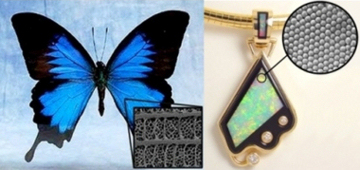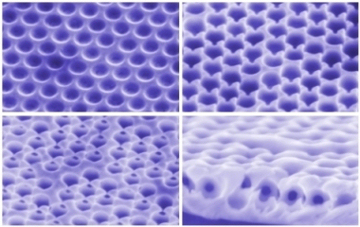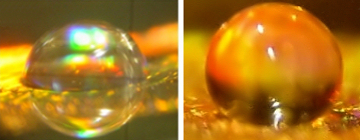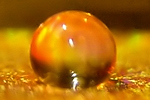General Introduction to Nano-structures
Relating to work conducted from 2002 to 2006
 During my time in academia much of the research involved nano-structures. One nanometre is one thousand millionth of a meter and, loosely speaking, structures up to a millionth of a meter are still classed as nano - this the regime in which I have mainly worked: big nano-structures. This size scale is interesting because it is similar to that of the wavelength of visible light, and so produces many strange optical effects. The butterfly's wing and the piece of opal are great examples of how structuring on this size scale leads to strong optical effects and vivid colours. The butterfly's wing acts as an optical filter, only reflecting blue light and producing the vibrant colours we see. It is important to note that the better the ordering of the structure (shown in the insets) the stronger the optical effect will be. The opal acts in much the same way as the wing, but has a more random structure, leading to the reflection of different colours from different places. Thus, to study these effects it is useful to have as close to perfect ordering as possible.
During my time in academia much of the research involved nano-structures. One nanometre is one thousand millionth of a meter and, loosely speaking, structures up to a millionth of a meter are still classed as nano - this the regime in which I have mainly worked: big nano-structures. This size scale is interesting because it is similar to that of the wavelength of visible light, and so produces many strange optical effects. The butterfly's wing and the piece of opal are great examples of how structuring on this size scale leads to strong optical effects and vivid colours. The butterfly's wing acts as an optical filter, only reflecting blue light and producing the vibrant colours we see. It is important to note that the better the ordering of the structure (shown in the insets) the stronger the optical effect will be. The opal acts in much the same way as the wing, but has a more random structure, leading to the reflection of different colours from different places. Thus, to study these effects it is useful to have as close to perfect ordering as possible.
 There are many ways to produce structures the nano scale; however, in the case of the structures I studied for my PhD the surfaces were produced using one of the fundamental properties of spheres - if you put them in a box they will fall into a neat hexagonal pattern. In reality at the small scale, it is far more challenging than this, but the chemists on the project have perfected the art and can make amazing arrays of nano spheres over large areas. These arrays are interesting in themselves, however wishing for more of a challenge, gold was electroplated through the template of spheres to create a honeycomb structure. Following this, the spheres are removed so as to be left with their cast. Whilst appearing quite straightforward, in fact these structures are still very hard to fully understand from an optical point of view, so structures were limited to the use of a single layer of voids on the surface. The picture opposite shows an electron micrograph of such a gold surface.
There are many ways to produce structures the nano scale; however, in the case of the structures I studied for my PhD the surfaces were produced using one of the fundamental properties of spheres - if you put them in a box they will fall into a neat hexagonal pattern. In reality at the small scale, it is far more challenging than this, but the chemists on the project have perfected the art and can make amazing arrays of nano spheres over large areas. These arrays are interesting in themselves, however wishing for more of a challenge, gold was electroplated through the template of spheres to create a honeycomb structure. Following this, the spheres are removed so as to be left with their cast. Whilst appearing quite straightforward, in fact these structures are still very hard to fully understand from an optical point of view, so structures were limited to the use of a single layer of voids on the surface. The picture opposite shows an electron micrograph of such a gold surface.
 These dishes are 600 nm in diameter (the same size as red light) and pictures have been taken at different thicknesses of gold used during the casting process - this alters the amount of the sphere that is cast, and produces structures ranging from shallow dishes to encapsulated voids.
These dishes are 600 nm in diameter (the same size as red light) and pictures have been taken at different thicknesses of gold used during the casting process - this alters the amount of the sphere that is cast, and produces structures ranging from shallow dishes to encapsulated voids.
It is found that even the simple act of placing a droplet of water on such a surface becomes a complex scientific problem. For example, altering the dish shape by changing the thickness changes the way the water droplet sits on the surface; shifting from sitting low to stand proud of the surface as the structuring modifies the surface tension, as shown.
The structuring of the surface also creates many interesting optical effects, similar to that of the butterfly wing, but now more complex as the surface is a metal not an insulator. This leads to the light also interacting with the electrons in the surface and creating an entity known as a surface plasmon polariton. This where the light and the electrons get so mixed together, they act as if they were a new part-light, part-electron particle. This sounds strange and it is, and was the topic of my PhD. First to explore the properties of these entities, outlines in the Surface Plasmon Polariton section of this site, then to look at Surface Plasmon Interactions, and finally to explore Surface Enhanced Raman an effect that was novel during my PhD but is now routinely used for enhancing the detection of low concentrations of molecules.
Papers relating to this work:
 Wetting of Regularly Structured Gold Surfaces
Wetting of Regularly Structured Gold Surfaces
M.E. Abdelsalam, P.N. Bartlett, T.A. Kelf, and J.J. Baumberg.
Langmuir. 21, 1753 (2005).
 Thesis: Light-Matter Interactions on Nano-Structured Metallic Films
Thesis: Light-Matter Interactions on Nano-Structured Metallic Films
Work carried out at the University of Southampton under the supervison of Prof. J.J. Baumberg